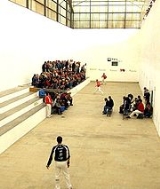
Escala i corda
Encyclopedia
Escala i corda is the most prestigious variant of Valencian pilota
, and the only one, with Raspall
, that have professional players.
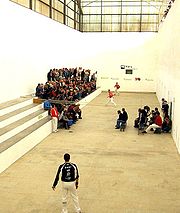
settled a 1.80 m high rope in the middle of a trinquet
and thus divided the courtfield in two sides. Until then, the midfield was variable, using the "ratlles" of the Llargues
modality.
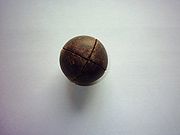 In the "Escala i corda" a kind of ball called pilota de vaqueta
In the "Escala i corda" a kind of ball called pilota de vaqueta
(Catalan
for little cow ball) is used, it's a small and extremely fast ball, very tough and good bouncer. The name comes from the fact that it's made of cow leather. The size for adults are 42 mm diameter, 138 mm circumference, and 42 gr of weight.
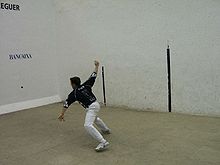 Matches are played to 12 games, counting 5 to 5: every game scoring is valid for 5 points. Every game is divided in 4 "quinzes" (15, 30, val and game). The team who first gets 60 points for 12 games is the winner.
Matches are played to 12 games, counting 5 to 5: every game scoring is valid for 5 points. Every game is divided in 4 "quinzes" (15, 30, val and game). The team who first gets 60 points for 12 games is the winner.
Every quinze begins when the "feridor" player throws the ball to the opponent "dauer", who must turn it back to the team in the "rest" midfield. This way, both teams will be sending each other the ball over the net with an only hit of the hand by team, they may hit the ball on the air or when it's bounced once on the ground, until one of the teams is not able to throw it back or a "fault " is committed.
"Faults":
There is also a way to get direct "quinzes", by throwing the ball to the gallery of the trinquet
or the "llotgeta" and without the ball coming back.
But there are competitions where it is not allowed (such as the Circuit Bancaixa
league), or special challenges. That's because this way is too easy for certain players and it's regarded as less spectacular. Anyway, in one-on-one matches "galleries" are allowed.
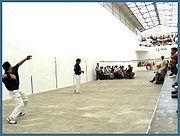 "Escala i corda" may be played one-on-one, but it's mainly a team sport. Teams may be formed by 2 or 3 players, and they may in every combination (2 vs. 2, 3 vs. 3, or 3 vs. 2 if those three players are considered not to be as good as the other two), this way bets are more interesting.
"Escala i corda" may be played one-on-one, but it's mainly a team sport. Teams may be formed by 2 or 3 players, and they may in every combination (2 vs. 2, 3 vs. 3, or 3 vs. 2 if those three players are considered not to be as good as the other two), this way bets are more interesting.
Anyway, the favourited team (the one organizers thinks is better) will dress in red, and the other one in blue.
Players are called according to their position in the "trinquet". So, there is "dauer", a "mitger" and a "punter". There use to be also two special players called the "feridors" which are raffled before the match begins to know who'll they play for (the "punter" may be the "feridor" as well).
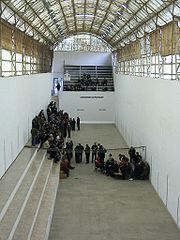 When entering into a trinquet
When entering into a trinquet
, spectators may choose where to seat. Some, the most careful will watch the match from the "galleries" on the top of the walls, and the bravest or scholars may be allowed to seat in the "llotgeta". Some selected people will seat under the rope (1,80 m high). But the main amount of fans will be on the "rest" midfield stairs.
Valencian pilota
Valencian pilota is a traditional handball sport played in the Valencian Community. Its origins are not known, but seems to be related to the French Jeu de paume....
, and the only one, with Raspall
Raspall
Raspall is a variant of the handball game, Valencian pilota, played mainly in the Valencian regions south to the Xúquer river: the Vall d'Albaida, the Safor, the Costera, the Marina Alta and the Marina Baixa. It is also popular in the Ribera Baixa...
, that have professional players.

History
"Escala i corda" variant began around 1910, when the player Nel de MurlaJosé Vicente Riera Calatayud
José Vicente Riera Calatayud , el Nel de Murla, is regarded to be the first Valencian pilota genius.He was 23 and got announced as the main player at the Pelayo and Juan de Mena trinquets, in Valencia...
settled a 1.80 m high rope in the middle of a trinquet
Valencian trinquet
Valencian trinquet, or simply trinquet , is the court used in the Valencian Community for two different modalities of Valencian pilota: the Escala i corda and the Raspall.- Court :...
and thus divided the courtfield in two sides. Until then, the midfield was variable, using the "ratlles" of the Llargues
Llargues
Llargues is the oldest Valencian pilota modality. It's played on the streets, where two teams formed by 3, 4 or 5 players throw each other the ball with the hand try to surpass an imaginary line which changes every game....
modality.
Ball

Vaqueta ball
The vaqueta ball is the kind of ball used to play some Valencian pilota variants: Escala i corda, Galotxa and Raspall. Its name derives from the fact that it's made of bull's skin, hence its black colour , this way the ball contrasts with the white colour of the trinquets' walls.- Traits :The...
(Catalan
Catalan language
Catalan is a Romance language, the national and only official language of Andorra and a co-official language in the Spanish autonomous communities of Catalonia, the Balearic Islands and Valencian Community, where it is known as Valencian , as well as in the city of Alghero, on the Italian island...
for little cow ball) is used, it's a small and extremely fast ball, very tough and good bouncer. The name comes from the fact that it's made of cow leather. The size for adults are 42 mm diameter, 138 mm circumference, and 42 gr of weight.
Rules
The objective of an Escala i corda game is sending the ball over a net by hitting it with the hand. When the opponent doesn't get it the sending team wins the quinze.
Every quinze begins when the "feridor" player throws the ball to the opponent "dauer", who must turn it back to the team in the "rest" midfield. This way, both teams will be sending each other the ball over the net with an only hit of the hand by team, they may hit the ball on the air or when it's bounced once on the ground, until one of the teams is not able to throw it back or a "fault " is committed.
"Faults":
- When the ball bounces twice, or the same team (or player) touches it twice.
- When the ball touches the net or passes under it.
- When, in the "ferida", the ball doesn't enter into the "dau"
There is also a way to get direct "quinzes", by throwing the ball to the gallery of the trinquet
Valencian trinquet
Valencian trinquet, or simply trinquet , is the court used in the Valencian Community for two different modalities of Valencian pilota: the Escala i corda and the Raspall.- Court :...
or the "llotgeta" and without the ball coming back.
But there are competitions where it is not allowed (such as the Circuit Bancaixa
Circuit Bancaixa
The Circuit Bancaixa , officially Lliga Professional d'Escala i Corda, is the Escala i corda league for this Valencian pilota modality professional players...
league), or special challenges. That's because this way is too easy for certain players and it's regarded as less spectacular. Anyway, in one-on-one matches "galleries" are allowed.
Players

Anyway, the favourited team (the one organizers thinks is better) will dress in red, and the other one in blue.
Players are called according to their position in the "trinquet". So, there is "dauer", a "mitger" and a "punter". There use to be also two special players called the "feridors" which are raffled before the match begins to know who'll they play for (the "punter" may be the "feridor" as well).
- The dauer (also called as "rest", "reboter", or "escalater") is the player closer to the walls, hence, he's in charge of throwing back the bouncing balls and the main amount of balls sent to the stairs. He, as well, will begin every "quinze" by standing into the "dau" and replying the serve of the "feridor". He uses to be the player who plays the "caiguda d'escala".
- The mitger is positioned in the middle of his teams' field and his main shot is on the air, when the ball hasn't bounced on the ground. If the ball has bounced once he is able to aim and throw the ball to the corners, to the non-protected places of the opponent team, or to the special places as the "galleries", the "llotgeta" or the stairs.
- The punter is the player closer to the net, that's why he's who'll play less balls (because they are so fast they won't be able to hit them properly) and who needs less strength in order to throw it back, but also, he'll receive the stronger balls, hence he'll use more protections on the hands.
- The feridor is a special player. He might be a "punter", but many times, before the match begins, two "feridors" are raffled in order to know who'll they play for. He's in charge of beginning every "quinze" by throwing the ball to the "dau", this serve is called "ferida" (Catalan for "wound"), because the more difficult to play the "dauer" receives the ball the more painful it'll be.
Spectators

Valencian trinquet
Valencian trinquet, or simply trinquet , is the court used in the Valencian Community for two different modalities of Valencian pilota: the Escala i corda and the Raspall.- Court :...
, spectators may choose where to seat. Some, the most careful will watch the match from the "galleries" on the top of the walls, and the bravest or scholars may be allowed to seat in the "llotgeta". Some selected people will seat under the rope (1,80 m high). But the main amount of fans will be on the "rest" midfield stairs.
Competitions
- Circuit BancaixaCircuit BancaixaThe Circuit Bancaixa , officially Lliga Professional d'Escala i Corda, is the Escala i corda league for this Valencian pilota modality professional players...
, teams- Circuit Bancaixa 07/08Circuit Bancaixa 07/08The Escala i Corda XVII Professional League 07-08 of the Circuit Bancaixa is the top-level championship of the Escala i corda, a modality of Valencian pilota, organized by the firm ValNet...
- Circuit Bancaixa 07/08
- Trofeu Individual BancaixaTrofeu Individual BancaixaThe Trofeu Individual Bancaixa "Bancaixa one-on-one trophy") is the Escala i corda singles league played by Valencian pilota professionals and promoted by the Bancaixa bank.- Statistics :- Relevant facts about the Trofeu Individual Bancaixa :...
, singles- Trofeu Individual Bancaixa 2007Trofeu Individual Bancaixa 2007The Trofeu Individual Bancaixa 2007 is the 22nd season of the Trofeu Individual Bancaixa, the one-on-one trophy of Escala i corda, a variant of Valencian pilota.- Since Previous round :* Colau of La Pobla de Vallbona* Pedro of València...
- Trofeu Individual Bancaixa 2007

